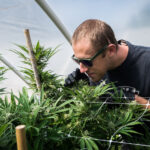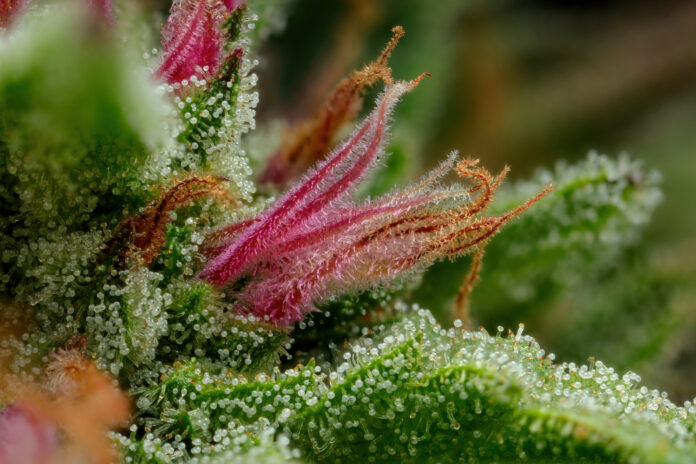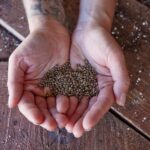All good things come in threes, but cultivators are just beginning to understand how this famed Latin principle applies to cannabis genetics. The weed we know and love is typically constructed with a pair of chromosomes (diploid) and a limited number of phenotype possibilities. However, cultivators are becoming aware of a new plant variation that can occasionally occur as a natural phenomenon: predominantly-seedless cannabis plants known as triploids.
What are triploid genetics?
Triploid cannabis seeds are developed by crossing a diploid with a tetraploid—a female cannabis plant containing two pairs of chromosomes instead of the standard one. Breeders around the world are just starting to dig into the process, its best practices, and what it might mean for the future of cannabis production.
While the sound of extra chromosomes might cause the cannabis enthusiasts to raise their eyebrows, the concept isn’t new, nor is it a genetic modification. Take a look through your kitchen and you’ll find a wide variety of polyploids from bananas and grapes to wheat and strawberries. Polyploids (plant cells containing more than two pairs of chromosomes) have been the revolution within breeding of domesticated crops and are common among plants and certain groups of fish and amphibians.
Until now, triploids have been a rare, random and special occurrence in cannabis flower, but today’s commercial growers are embarking on intentional ways to produce nearly-seedless cannabis for a few different reasons. When we take a look at other species that have been bred as polyploids, the main benefits tend to be higher yields and an increase in secondary metabolites. In the case of cannabis, that means the potential for elevated cannabinoids, and increased terpene levels, and larger trichomes. That’s the big goal everyone is aiming for with triploid breeding.
The result of triploid breeding yields faster flowering times and larger bud sets. This is a trend we see globally in polyploid agriculture. If you look at the fruit historically, the seeded grape is pretty small. But today’s seedless versions available in national grocery stores are massive, with two or three ‘grapes’ worth of fruit in a single grape.
The same idea applies to cannabis. Triploid plants would potentially have bigger cells, which would lead to bigger everything. Broader leaves, bigger flower, and maybe even bigger trichomes—at least that’s why fresh frozen extractors are keeping their fingers crossed. The more we look into triploid production, the more we realize that polyploids just might be the next step to even larger yields.
Some other potential benefits include more potent and aromatic products, increased vigor, better heat and drought tolerance, and less of a need for fertilizer and water. This means environmental impact would be significantly reduced, and the industry would be leaving a lighter carbon footprint. Although we can recognize their presence, we’re still trying to figure out to what extent these benefits will express themselves especially in high-THC cannabis. Right now, we see that the benefits indeed exist, but we’re essentially going into a dark room and shining a flashlight around. We can see that there’s some really cool stuff in here, but we’re still trying to figure out exactly how it all works together.
Remaining mystery aside, triploids will allow for yet unseen variations in phenotypes—Exponentially more genetic possibilities within a plant or cell. That means we’ll begin to see more diversity in terpenes and cannabinoids, and it will likely open up the ability for growers to cultivate varieties of cannabis in bioregions where it was challenging in the past.
This is particularly great news for members of the medical community, who would have wider ranging access to cannabis varietals for research purposes, contributing to a higher likelihood of the discovery of medically-beneficial strains and compounds. Through large-scale pheno hunting efforts researchers will be able to dive deeper into the triploid genome and get a better idea of what they have to offer. Triploids still require a lot of research and development, but they’re quite possibly the next big leap in cannabis evolution.
With any new practice comes the potential for drawbacks, and triploids do have one. An increased reliance on triploid production means significantly fewer seeds. Triploids are the ‘mule’ of the cannabis world, in that they are a genetic endpoint and unable to be bred further. Diploids will still be needed to produce triploid seeds. However, even this drawback is still a net positive helping to prevent the possibility of unintended pollination.
Cannabis has long been revered for its psychoactive properties, and cultivation nerds are consistently intent on seeing what other chemicals this plant is capable of producing. There’s a big incentive in this arena for breeders to keep exploring and seeing what else is out there. Can we achieve higher production of cannabinoids with triploids? Are there other cannabinoids we haven’t even seen yet? Will we finally see that true 40-percent THC that isn’t just a fictitious lab fever dream?
Although the territory is still largely uncharted, we have the rest of the agricultural industry to look to for clues—particularly the hops plant, which is quite similar to cannabis in its genetic makeup. With triploid hops, we’ve seen more robust plants and bigger production alongside stronger smell and taste. Because of that, we’re expecting to see similar results in cannabis over time. We just have to keep exploring and trust in the fact that for cannabis, triplets might just be superior to twins.













[…] into concentrates or hash can help companies create new products and utilize the plant to its full potential. Each extraction method presents its own set of challenges, but the right machines can mitigate […]
[…] conditions, and media are essential for commercial growers trying to push their plants to their full genetic potential. With a small array of industry-focused sensors or handheld devices, forward-thinking cultivators […]
[…] Ed Rosenthal, ska rock prodigies Slightly Stoopid, and fellow breeders Sensi Seeds. The company’s new triploid varieties, which are resistant to pollination, could be the future of growing cannabis […]
[…] final breeding boss—at least for now—cannabis triploids are gaining steam at the forefront of cannabis production. The result of a cross between a standard […]
[…] new 30,000-square-foot facility will grow everything from seed to flower with some of the most unique offerings in the state. The indoor facility is equipped with […]
[…] a chance to think a little less about the menial and focus on bigger-picture items like branding, developing new strains, and collaborating with other […]
[…] of plant growth to influence cannabinoid and terpene production. In an industry becoming more fixated on crop-steering and relying on analytics to determine which strains to grow, LED technology has become a critical […]